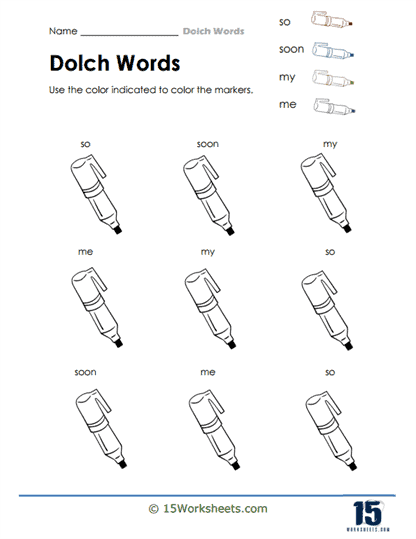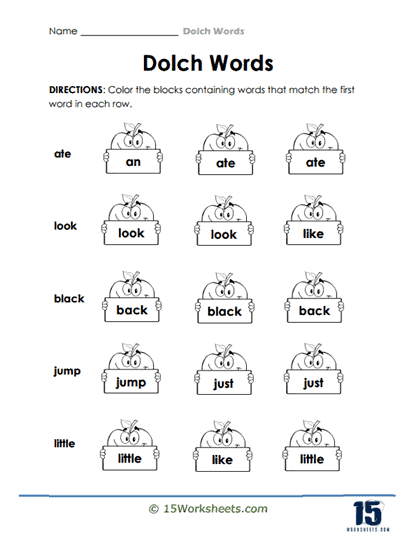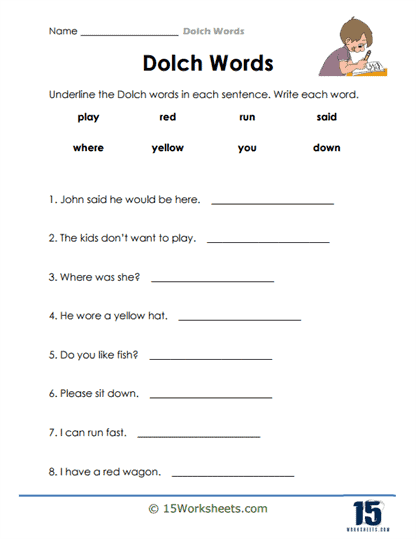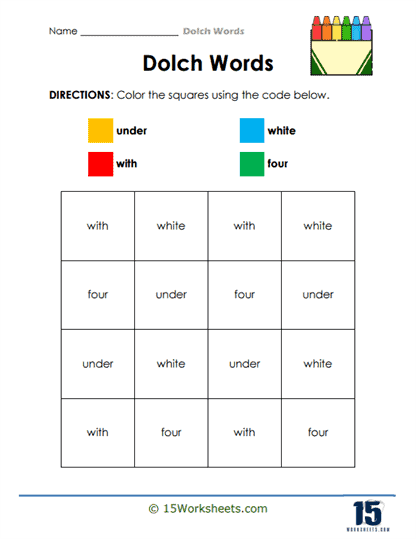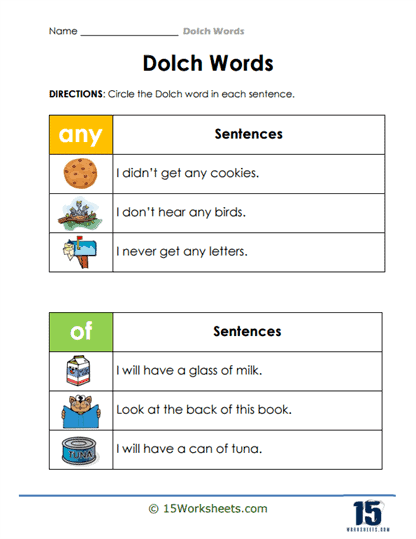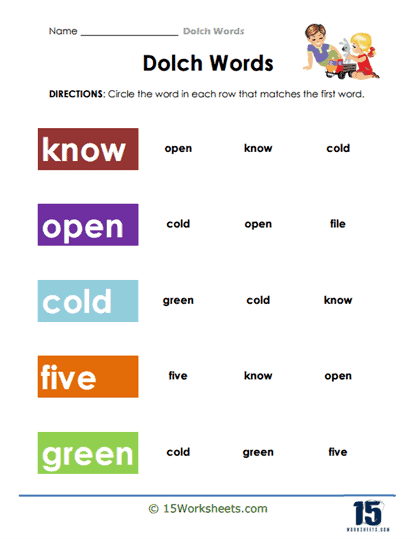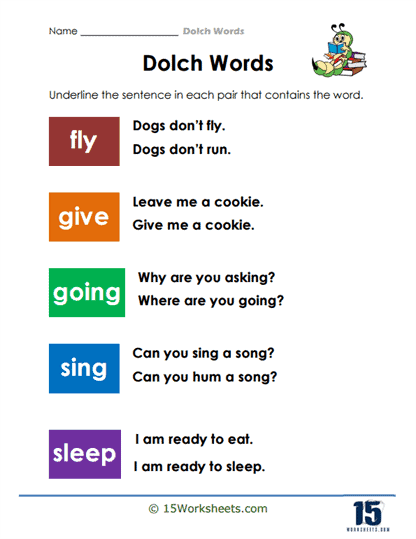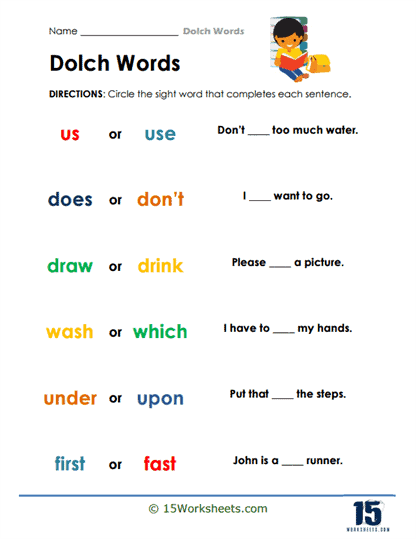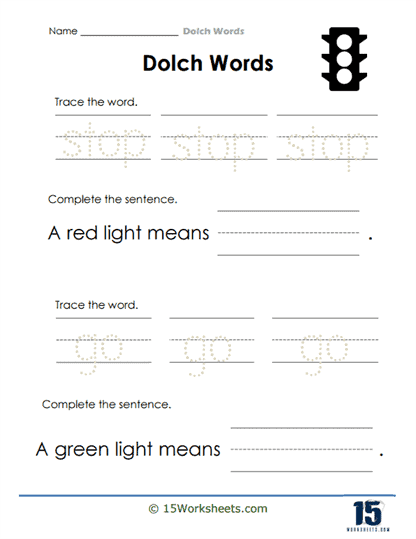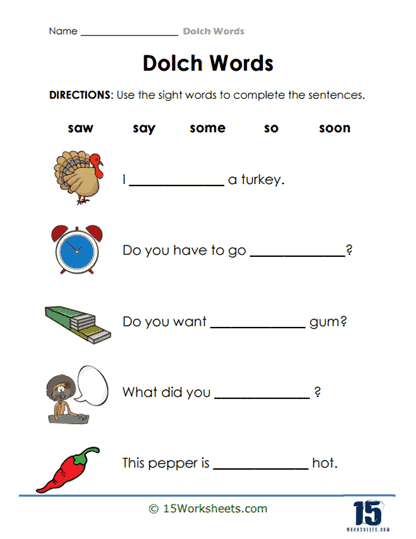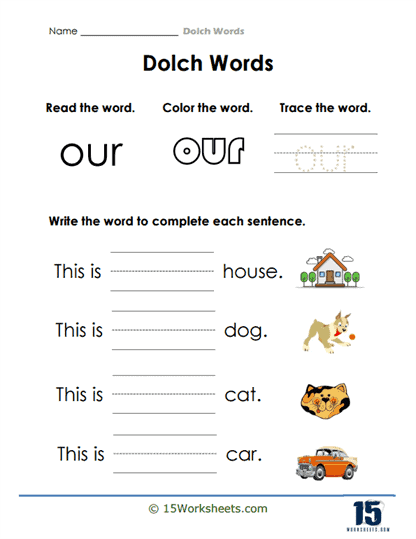Dolch Words Worksheets
About These 15 Worksheets
These worksheets were cretaed to enhance the reading and comprehension skills of young learners, particularly in the early stages of language development. Named after Edward William Dolch, who compiled the list in the 1930s, these worksheets focus on a set of high-frequency words that are vital for reading fluency in English. The Dolch list contains 220 “service words” and 95 high-frequency nouns. These words are not easily illustrated through pictures and are often words that children are encouraged to recognize by sight to improve reading speed and comprehension.
The variety of exercises found on Dolch Words Worksheets caters to different learning styles and helps reinforce the recognition and usage of these essential words. Let’s delve into the different types of exercises commonly found in these worksheets:
Word Recognition Drills – These exercises are designed to enhance the ability to recognize Dolch words quickly and accurately. They may involve matching words to pictures, identifying words in a list, or selecting Dolch words from a mixed group of words.
Fill-in-the-Blank Sentences – Here, children are given sentences with missing words, which they must fill in using appropriate Dolch words. This exercise not only helps in word recognition but also in understanding the context in which these words are used.
Flashcard Activities – Flashcards are a classic tool in language learning. In this exercise, Dolch words are printed on cards. Teachers or parents flash these cards to children, who then read the word aloud. This method is effective in building quick recognition skills.
Word Bingo – Turning learning into a game enhances engagement. Word Bingo uses a grid of Dolch words, and as the teacher calls out words, students mark them on their Bingo cards. This game is excellent for group learning and reinforces word recognition in a fun, interactive way.
Word Searches and Crosswords – These puzzles make the process of learning Dolch words engaging. Children search for Dolch words in a grid or complete crosswords where clues lead to Dolch words. This exercise not only aids in word recognition but also enhances spelling skills.
Sentence Building Exercises – In these exercises, students use Dolch words to construct sentences. This activity helps in understanding the practical application and contextual usage of words, enhancing both writing and comprehension skills.
Unscramble the Words – This involves providing children with scrambled letters that they need to arrange to form a correct Dolch word. It’s a great way to reinforce spelling and word recognition.
Color by Word – Similar to color by number, in this exercise, different areas of a picture are labeled with Dolch words. Children color each area based on a provided key. This method associates learning with an enjoyable activity, making it especially effective for visual learners.
Handwriting Practice – Worksheets may include lined sections where children practice writing Dolch words. This exercise aids in memorization and improves handwriting skills.
Cloze Stories – Longer than fill-in-the-blank sentences, cloze stories are short narratives or paragraphs with missing Dolch words. Children fill in the blanks, enhancing their ability to understand and use these words in context.
Word Sorting – In this activity, children sort words into various categories, such as parts of speech or by the number of letters. This helps in understanding the different characteristics and uses of words.
Rhyming Words – Here, children find and match Dolch words that rhyme. This exercise is beneficial for auditory learners and helps in developing phonemic awareness.
Word Pairs – Students create pairs of Dolch words that go together, like “sun” and “shine” or “rain” and “coat”. This not only aids in word recognition but also in understanding word relationships.
Sentence Unscrambling – This involves rearranging a group of words to form a coherent sentence. It’s an excellent way for children to practice sentence structure and the contextual use of words.
Reading Comprehension Passages – These are short passages that predominantly use Dolch words. After reading, children answer questions about the passage, enhancing their reading comprehension skills.
Each of these exercises serves a specific purpose in the learning process. Word recognition drills and flashcard activities are foundational, building the initial recognition of words. Activities like fill-in-the-blanks, sentence building, and cloze stories enhance comprehension and usage in context. Crosswords, word searches, and color by word exercises make the learning process engaging and cater to different learning styles. Handwriting and unscrambling activities further reinforce spelling and grammatical skills. Lastly, reading comprehension passages bring together all the elements of learning, showcasing the student’s overall progress in recognizing and understanding Dolch words.
What Are Dolch Words?
The goal of teaching Dolch Words is to enable children to automatically recognize these words, thereby improving their reading speed and comprehension. Being familiar with these words allows young readers to focus on understanding the content of the text without being bogged down by frequent stops to decode individual words. This foundational skill is crucial for developing reading confidence and proficiency in young learners.
Dolch Words, also known as “sight words,” are a list of common English words compiled by Edward William Dolch, PhD. These words are considered fundamental for young children to learn as they are frequently found in English-language literature, especially in children’s books. Dolch published his list in 1948 in the book “Problems in Reading.”
Dolch identified these words based on their frequency and necessity for reading and comprehension. The list comprises 220 “service words” and 95 nouns. The service words include pronouns, adjectives, adverbs, prepositions, conjunctions, and verbs. The uniqueness of Dolch Words lies in the fact that many of them cannot be easily sounded out or illustrated, and are thus best learned through sight and memory.
How Do They Help Students?
Dolch Words, a vital component in the realm of early reading development, are among the most frequently used words in the English language. Their significance is particularly notable in children’s literature, as they form a large proportion of the words found in children’s books. This high frequency makes them an essential element in the foundational stages of reading education.
The impact of Dolch Words on reading fluency is substantial. As children learn these words, they become more fluent and efficient readers. This improvement is largely because Dolch Words often appear in sentences and are not always amenable to phonetic decoding. By familiarizing themselves with these words, young readers can navigate texts more smoothly and with greater ease.
In terms of comprehension, the role of Dolch Words cannot be overstated. These words are fundamental to understanding the content of what is read. Their frequent use in text means that a solid mastery of Dolch Words significantly enhances a child’s ability to comprehend reading material. This understanding is crucial for the development of more advanced reading skills.
The Dolch list is structured in a way that facilitates systematic learning. It is typically divided into different levels, usually organized by grade, from pre-kindergarten to third grade. Additionally, there is a separate list dedicated to nouns. This structured approach helps educators and parents introduce these words in a gradual and effective manner, tailored to a child’s learning stage.
The teaching methods employed for Dolch Words focus primarily on sight recognition. Techniques such as the use of flashcards, repetitive reading, and visual cues are commonly utilized. These methods are particularly effective due to the nature of Dolch Words, many of which do not conform to regular phonetic patterns. Consequently, memorization by sight is often recommended for words like “the,” “said,” “you,” and “where,” which defy standard phonetic rules.




